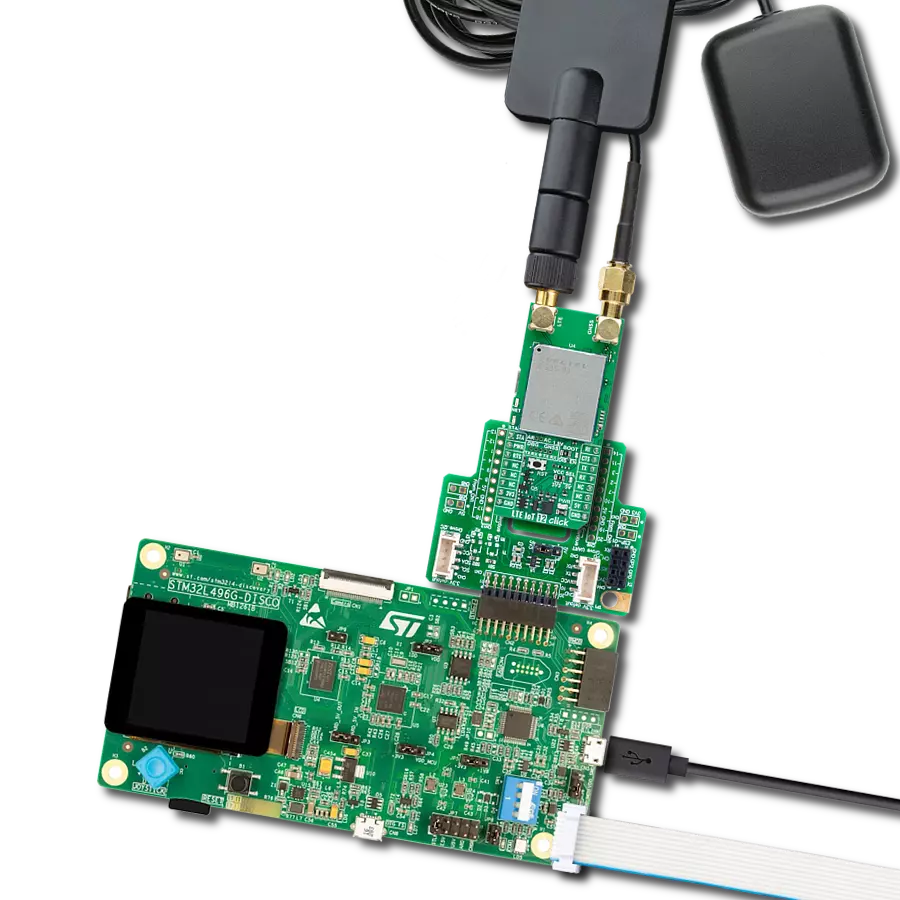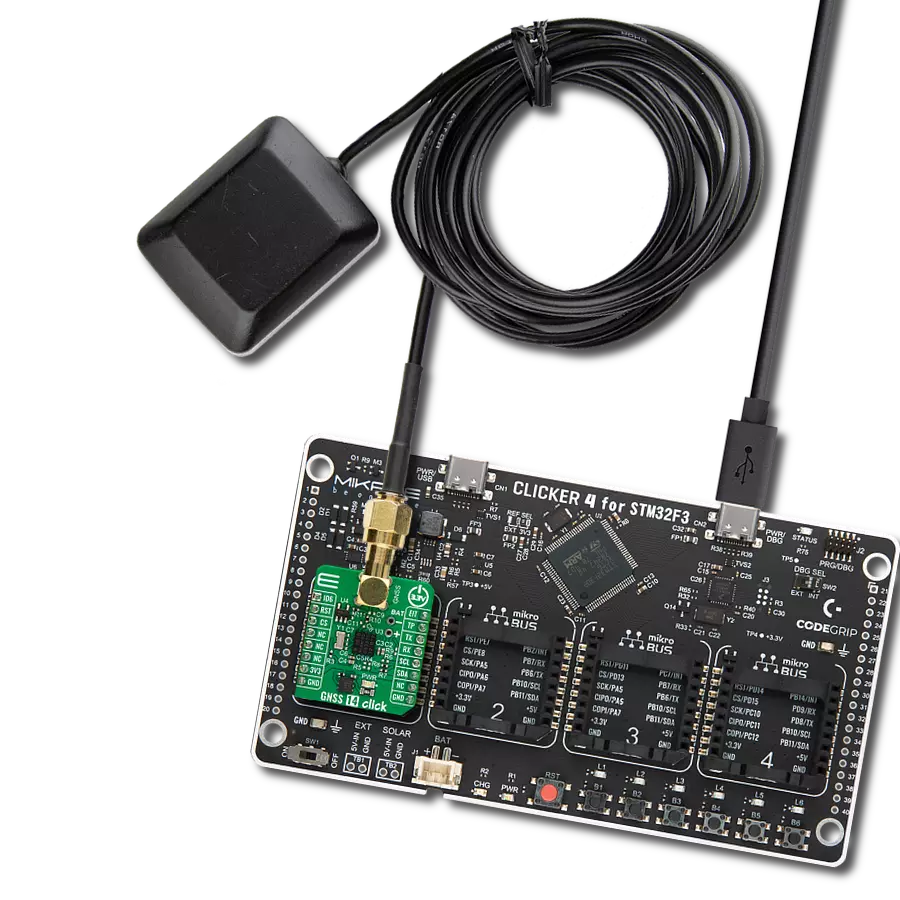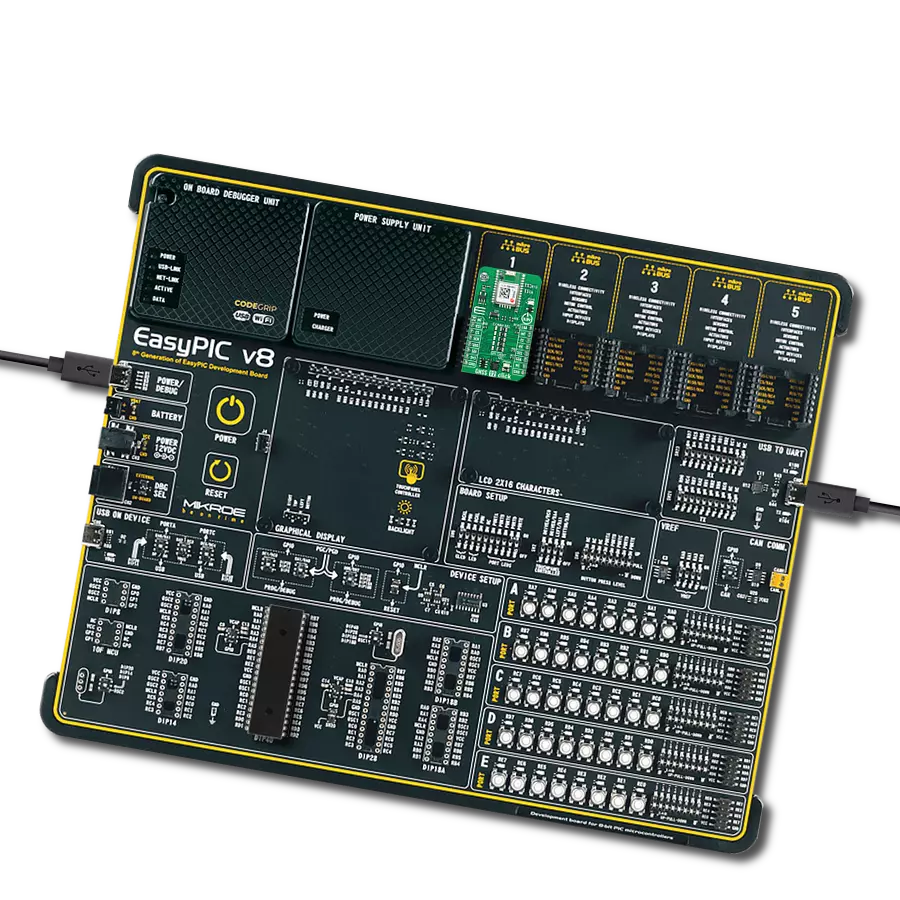支持依赖准确位置信息的应用,例如导航、地图绘制和增强现实
A
A
硬件概览
它是如何工作的?
GNSS MAX 2 Click 基于 u-blox 的 MAX-F10S,这是一款专业级的 L1/L5 双频 GNSS 接收器,设计用于即使在具有挑战性的城市环境中也能实现米级精度。该板基于 u-blox F10 GNSS 技术,利用 L1 和 L5 GNSS 频段以提高精度。双频能力使 MAX-F10S 能够减轻多径效应,利用 L1 和 L5 频段的信号提供比单频接收器更显著的定位精度提升。此 Click board™ 非常适合各种需要在城市环境中进行可靠精确定位的应用,如车辆跟踪、车队管理、微出行解决方案等,即使使用小型天线也能提供显著优势。作为一个并发 GNSS 接收器,MAX-F10S 可以同时跟踪多个 GNSS 星座,包括 GPS、Galileo 和北斗系统,并启用了 SBAS,确保在复杂城市地区的可靠表现。其射频前端架构设计为能够同时接收双频信号,提供高灵敏度
和更高的准确性。为了进一步增强其可靠性,该模块包括两个内部 SAW 滤波器和一个低噪声放大器 (LNA),可以保护接收器免受附近蜂窝调制解调器引起的射频干扰。其高效的电源管理系统还允许接收器仅使用一部分 GNSS 星座,降低功耗的同时保持高精度。GNSS MAX 2 Click 通过 UART 接口与主 MCU 通信,使用标准的 UART RX 和 TX 引脚。默认通信速度设置为 9600bps,确保高效数据交换。它还提供了 I2C 接口,用于与主 MCU 以 I2C 快速模式通信。但需注意的是,I2C 接口只能在从属模式下运行。除了接口引脚外,该 Click board™ 还集成了一个复位引脚 (RST),用于直接复位模块,以及一个外部中断信号 (EXI),可以编程用于各种功能,如唤醒模块。此外,GNSS 17 Click 包含一个红色 PPS LED 指示
灯,它每秒发出一次与 MAX-F10S 同步的脉冲信号。PPS 功能默认启用,当模块达到 3D 定位时将输出 PPS 信号。此 Click board™ 还配备了一个 50Ω 阻抗的 SMA 天线连接器,兼容 MIKROE 提供的各种天线,如 Active GPS 天线,以增强其连接性。此外,在主电源失效的情况下,模块可以使用从连接电池中获取的备用电源,使得您可以将 Click board™ 用作独立设备。此 Click board™ 只能使用 3.3V 逻辑电压级运行。在使用其他逻辑电压级的 MCU 之前,必须进行适当的逻辑电压级转换。此外,它还配备了一个包含函数库和示例代码的库,可作为进一步开发的参考。
功能概述
开发板
Curiosity PIC32 MZ EF 开发板是一个完全集成的 32 位开发平台,特点是高性能的 PIC32MZ EF 系列(PIC32MZ2048EFM),该系列具有 2MB Flash、512KB RAM、集成的浮点单元(FPU)、加密加速器和出色的连接选项。它包括一个集成的程序员和调试器,无需额外硬件。用户可以通过 MIKROE
mikroBUS™ Click™ 适配器板扩展功能,通过 Microchip PHY 女儿板添加以太网连接功能,使用 Microchip 扩展板添加 WiFi 连接能力,并通过 Microchip 音频女儿板添加音频输入和输出功能。这些板完全集成到 PIC32 强大的软件框架 MPLAB Harmony 中,该框架提供了一个灵活且模块化的接口
来应用开发、一套丰富的互操作软件堆栈(TCP-IP、USB)和易于使用的功能。Curiosity PIC32 MZ EF 开发板提供了扩展能力,使其成为连接性、物联网和通用应用中快速原型设计的绝佳选择。
微控制器概述
MCU卡片 / MCU

建筑
PIC32
MCU 内存 (KB)
2048
硅供应商
Microchip
引脚数
100
RAM (字节)
524288
你完善了我!
配件
主动 GPS 天线旨在增强您的 GPS 和 GNSS Click 板™ 的性能。这款外置天线结构坚固,适用于各种天气条件。凭借 1575.42MHz 的频率范围和 50Ohm 的阻抗,它确保了可靠的信号接收。天线在较宽的角度范围内提供大于 -4dBic 的增益,确保超过 75% 的覆盖率。± 5MHz 的带宽进一步保证了精确的数据采集。天线采用右旋圆极化 (RHCP),提供稳定的信号接收。其紧凑的尺寸为 48.5×39×15mm,配有 2 米长的电缆,安装方便。磁性天线类型与 SMA 公连接器确保了安全便捷的连接。如果您需要为定位设备提供可靠的外置天线,我们的主动 GPS 天线是完美的解决方案。

使用的MCU引脚
mikroBUS™映射器
“仔细看看!”
Click board™ 原理图

一步一步来
项目组装
实时跟踪您的结果
应用程序输出
1. 应用程序输出 - 在调试模式下,“应用程序输出”窗口支持实时数据监控,直接提供执行结果的可视化。请按照提供的教程正确配置环境,以确保数据正确显示。

2. UART 终端 - 使用UART Terminal通过USB to UART converter监视数据传输,实现Click board™与开发系统之间的直接通信。请根据项目需求配置波特率和其他串行设置,以确保正常运行。有关分步设置说明,请参考提供的教程。

3. Plot 输出 - Plot功能提供了一种强大的方式来可视化实时传感器数据,使趋势分析、调试和多个数据点的对比变得更加直观。要正确设置,请按照提供的教程,其中包含使用Plot功能显示Click board™读数的分步示例。在代码中使用Plot功能时,请使用以下函数:plot(insert_graph_name, variable_name);。这是一个通用格式,用户需要将“insert_graph_name”替换为实际图表名称,并将“variable_name”替换为要显示的参数。

软件支持
库描述
该库包含 GNSS MAX 2 Click 驱动程序的 API。
关键功能:
gnssmax2_generic_read- 此函数使用 UART 或 I2C 串行接口读取所需数量的数据字节。gnssmax2_parse_gga- 此函数从读取的响应缓冲区中解析 GGA 数据。gnssmax2_reset_device- 此函数通过切换 RST 引脚来重置设备。
开源
代码示例
完整的应用程序代码和一个现成的项目可以通过NECTO Studio包管理器直接安装到NECTO Studio。 应用程序代码也可以在MIKROE的GitHub账户中找到。
/*!
* @file main.c
* @brief GNSS MAX 2 Click Example.
*
* # Description
* This example demonstrates the use of GNSS MAX 2 Click by reading and displaying
* the GNSS coordinates.
*
* The demo application is composed of two sections :
*
* ## Application Init
* Initializes the driver and logger.
*
* ## Application Task
* Reads the received data, parses the NMEA GGA info from it, and once it receives
* the position fix it will start displaying the coordinates on the USB UART.
*
* ## Additional Function
* - static void gnssmax2_clear_app_buf ( void )
* - static void gnssmax2_log_app_buf ( void )
* - static err_t gnssmax2_process ( gnssmax2_t *ctx )
* - static void gnssmax2_parser_application ( uint8_t *rsp )
*
* @author Stefan Filipovic
*
*/
#include "board.h"
#include "log.h"
#include "gnssmax2.h"
// Application buffer size
#define APP_BUFFER_SIZE 500
#define PROCESS_BUFFER_SIZE 200
static gnssmax2_t gnssmax2;
static log_t logger;
static uint8_t app_buf[ APP_BUFFER_SIZE + 1 ] = { 0 };
static int32_t app_buf_len = 0;
static uint8_t i2c_data_ready = 0;
/**
* @brief GNSS MAX 2 clearing application buffer.
* @details This function clears memory of application buffer and reset its length.
* @note None.
*/
static void gnssmax2_clear_app_buf ( void );
/**
* @brief GNSS MAX 2 log application buffer.
* @details This function logs data from application buffer to USB UART.
* @note None.
*/
static void gnssmax2_log_app_buf ( void );
/**
* @brief GNSS MAX 2 data reading function.
* @details This function reads data from device and concatenates data to application buffer.
* @param[in] ctx : Click context object.
* See #gnssmax2_t object definition for detailed explanation.
* @return @li @c 0 - Read some data.
* @li @c -1 - Nothing is read.
* See #err_t definition for detailed explanation.
* @note None.
*/
static err_t gnssmax2_process ( gnssmax2_t *ctx );
/**
* @brief GNSS MAX 2 parser application.
* @details This function logs GNSS data on the USB UART.
* @param[in] rsp Response buffer.
* @return None.
* @note None.
*/
static void gnssmax2_parser_application ( uint8_t *rsp );
void application_init ( void )
{
log_cfg_t log_cfg; /**< Logger config object. */
gnssmax2_cfg_t gnssmax2_cfg; /**< Click config object. */
/**
* Logger initialization.
* Default baud rate: 115200
* Default log level: LOG_LEVEL_DEBUG
* @note If USB_UART_RX and USB_UART_TX
* are defined as HAL_PIN_NC, you will
* need to define them manually for log to work.
* See @b LOG_MAP_USB_UART macro definition for detailed explanation.
*/
LOG_MAP_USB_UART( log_cfg );
log_init( &logger, &log_cfg );
log_info( &logger, " Application Init " );
// Click initialization.
gnssmax2_cfg_setup( &gnssmax2_cfg );
GNSSMAX2_MAP_MIKROBUS( gnssmax2_cfg, MIKROBUS_1 );
if ( GNSSMAX2_OK != gnssmax2_init( &gnssmax2, &gnssmax2_cfg ) )
{
log_error( &logger, " Communication init." );
for ( ; ; );
}
log_info( &logger, " Application Task " );
}
void application_task ( void )
{
if ( GNSSMAX2_OK == gnssmax2_process( &gnssmax2 ) )
{
gnssmax2_parser_application( app_buf );
}
}
int main ( void )
{
/* Do not remove this line or clock might not be set correctly. */
#ifdef PREINIT_SUPPORTED
preinit();
#endif
application_init( );
for ( ; ; )
{
application_task( );
}
return 0;
}
static void gnssmax2_clear_app_buf ( void )
{
memset( app_buf, 0, app_buf_len );
app_buf_len = 0;
}
static void gnssmax2_log_app_buf ( void )
{
for ( int32_t buf_cnt = 0; buf_cnt < app_buf_len; buf_cnt++ )
{
log_printf( &logger, "%c", app_buf[ buf_cnt ] );
}
}
static err_t gnssmax2_process ( gnssmax2_t *ctx )
{
uint8_t rx_buf[ PROCESS_BUFFER_SIZE ] = { 0 };
int32_t overflow_bytes = 0;
int32_t rx_cnt = 0;
int32_t rx_size = 0;
if ( ( GNSSMAX2_DRV_SEL_I2C == ctx->drv_sel ) && ( !i2c_data_ready ) )
{
uint16_t pps_wait_log_cnt = 0;
while ( !gnssmax2_get_pps_pin ( ctx ) )
{
if ( ++pps_wait_log_cnt > 5000 )
{
log_printf( &logger, " Waiting for the position fix (PPS signal)...\r\n\n" );
pps_wait_log_cnt = 0;
}
Delay_ms ( 1 );
}
i2c_data_ready = 1;
Delay_ms ( 200 );
}
rx_size = gnssmax2_generic_read( ctx, rx_buf, PROCESS_BUFFER_SIZE );
if ( ( rx_size > 0 ) && ( rx_size <= APP_BUFFER_SIZE ) )
{
if ( ( app_buf_len + rx_size ) > APP_BUFFER_SIZE )
{
overflow_bytes = ( app_buf_len + rx_size ) - APP_BUFFER_SIZE;
app_buf_len = APP_BUFFER_SIZE - rx_size;
memmove ( app_buf, &app_buf[ overflow_bytes ], app_buf_len );
memset ( &app_buf[ app_buf_len ], 0, overflow_bytes );
}
for ( rx_cnt = 0; rx_cnt < rx_size; rx_cnt++ )
{
if ( rx_buf[ rx_cnt ] && ( GNSSMAX2_DUMMY != rx_buf[ rx_cnt ] ) )
{
app_buf[ app_buf_len++ ] = rx_buf[ rx_cnt ];
}
}
return GNSSMAX2_OK;
}
return GNSSMAX2_ERROR;
}
static void gnssmax2_parser_application ( uint8_t *rsp )
{
uint8_t element_buf[ 200 ] = { 0 };
if ( GNSSMAX2_OK == gnssmax2_parse_gga( rsp, GNSSMAX2_GGA_LATITUDE, element_buf ) )
{
static uint8_t wait_for_fix_cnt = 0;
if ( strlen( element_buf ) > 0 )
{
log_printf( &logger, "\r\n Latitude: %.2s degrees, %s minutes\r\n", element_buf, &element_buf[ 2 ] );
memset( element_buf, 0, sizeof( element_buf ) );
gnssmax2_parse_gga( rsp, GNSSMAX2_GGA_LONGITUDE, element_buf );
log_printf( &logger, " Longitude: %.3s degrees, %s minutes\r\n", element_buf, &element_buf[ 3 ] );
memset( element_buf, 0, sizeof( element_buf ) );
gnssmax2_parse_gga( rsp, GNSSMAX2_GGA_ALTITUDE, element_buf );
log_printf( &logger, " Altitude: %s m\r\n", element_buf );
wait_for_fix_cnt = 0;
}
else
{
if ( wait_for_fix_cnt % 5 == 0 )
{
log_printf( &logger, " Waiting for the position fix...\r\n\n" );
wait_for_fix_cnt = 0;
}
wait_for_fix_cnt++;
}
gnssmax2_clear_app_buf( );
i2c_data_ready = 0;
}
}
// ------------------------------------------------------------------------ END
































